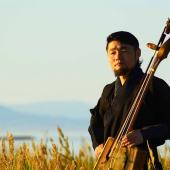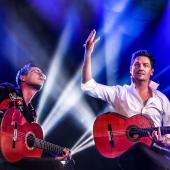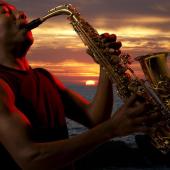Many people associate the samba with the famous carnival in Rio. The impressive festival on Rose Monday in February pays homage to the music and to the dance style every year in a special way. The best dance schools in Brazil act out in the specifically designed "Sambodromo". Samba is next to capoeira and Candomblé one of the most important Afro-Brazilian music traditions.
The samba once was imported with the slaves from Africa to Brazil. Today it is lived Brazilian folk culture. The original music of samba is characterized by short melodic lyrics and choruses. The basics of "Samba de Roda" were brought from Bahia to Rio de Janeiro in the second half of the 19th century by blacks. This Bahaian "Samba de Roda" was declared to Heritage of Humanity by the UNESCO in 2005.
The samba exists throughout the country. Particularly in the federal states of Bahia, Maranhao, Minas Gerais and Sao Paulo it is a form of expression for various popular rhythms and dances of the respective regions. In Rio de Janeiro, the samba then has established itself as an urban form of musical expression. The mixture of different musical genres such as polka, maxixe, lundu and others that were popular at that time, constitutes the unique character of the Rio samba. This specific form for this reason is called "Carnival Samba" or "Samba Carioca".
The modern versions of samba evolved around 1920 through innovations of a group of composers out of the carnival blocks from the districts Estácio de Sá and Osvaldo Cruz, and the Morros da Mangueira, Salgueiro and São Carlos. From then on, big samba brands appeared, including Ismael Silva, Cartola, Ari Barroso, Noel Rosa, Ataulfo Alves, Wilson Batista, Geraldo Pereira, Zé Keti, Ciro Monteiro, Nelson cavaquinho, Elton Medeiros, Paulinho da Viola, Martinho da Vila and a lot of others.
The samba is based on two-four times and variable dance steps. Traditionally, the samba is accompanied by stringed instruments such as the ukulele, as well as by various percussion instruments like the "pandeiro" (little hand drum), "surdo" (big clock drum) and the tambourine. Through the influence of North American music over time trombones, trumpets, flutes and clarinets were added. Around the rhythm of the music an entire samba culture developed: To Samba festivals specific menus are eaten, various dances such as the "miudinho", "coco", "Samba de Roda" or "pernada" are performed and also the most short, colourful clothes of the samba dancers has established over time.
The samba once was imported with the slaves from Africa to Brazil. Today it is lived Brazilian folk culture. The original music of samba is characterized by short melodic lyrics and choruses. The basics of "Samba de Roda" were brought from Bahia to Rio de Janeiro in the second half of the 19th century by blacks. This Bahaian "Samba de Roda" was declared to Heritage of Humanity by the UNESCO in 2005.
The samba exists throughout the country. Particularly in the federal states of Bahia, Maranhao, Minas Gerais and Sao Paulo it is a form of expression for various popular rhythms and dances of the respective regions. In Rio de Janeiro, the samba then has established itself as an urban form of musical expression. The mixture of different musical genres such as polka, maxixe, lundu and others that were popular at that time, constitutes the unique character of the Rio samba. This specific form for this reason is called "Carnival Samba" or "Samba Carioca".
The modern versions of samba evolved around 1920 through innovations of a group of composers out of the carnival blocks from the districts Estácio de Sá and Osvaldo Cruz, and the Morros da Mangueira, Salgueiro and São Carlos. From then on, big samba brands appeared, including Ismael Silva, Cartola, Ari Barroso, Noel Rosa, Ataulfo Alves, Wilson Batista, Geraldo Pereira, Zé Keti, Ciro Monteiro, Nelson cavaquinho, Elton Medeiros, Paulinho da Viola, Martinho da Vila and a lot of others.
The samba is based on two-four times and variable dance steps. Traditionally, the samba is accompanied by stringed instruments such as the ukulele, as well as by various percussion instruments like the "pandeiro" (little hand drum), "surdo" (big clock drum) and the tambourine. Through the influence of North American music over time trombones, trumpets, flutes and clarinets were added. Around the rhythm of the music an entire samba culture developed: To Samba festivals specific menus are eaten, various dances such as the "miudinho", "coco", "Samba de Roda" or "pernada" are performed and also the most short, colourful clothes of the samba dancers has established over time.




